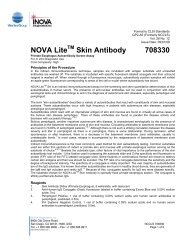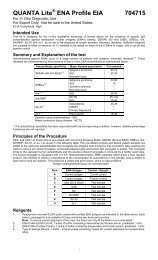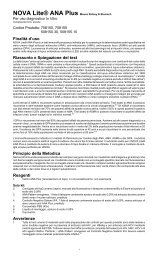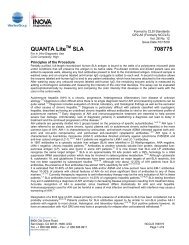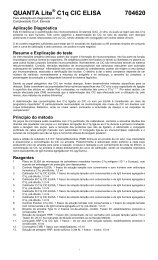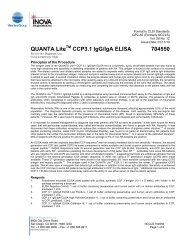NOVA Lite® ANCA IFA Kit - inova
NOVA Lite® ANCA IFA Kit - inova
NOVA Lite® ANCA IFA Kit - inova
- No tags were found...
You also want an ePaper? Increase the reach of your titles
YUMPU automatically turns print PDFs into web optimized ePapers that Google loves.
Interpretation of ResultsNegative Reactivity. A sample is considered negative if specific nuclear and cytoplasmic staining is equal toor less than the <strong>IFA</strong> System Negative Control. Samples can exhibit various degrees of background stainingdue to heterophile antibodies or low-level autoantibodies to cytoplasmic constituents such as contractileproteins.Positive Reactivity. A sample is considered positive if specific cytoplasmic staining as described below isobserved to be greater than the negative control and the staining intensity is 1+ or greater.Determine the fluorescence grade or intensity using these criteria:4+ Brilliant apple green fluorescence3+ Bright apple green fluorescence2+ Clearly distinguishable positive fluorescence1+ Lowest specific fluorescence that enables the nuclear and/or cytoplasmic staining to be clearlydifferentiated from the background fluorescencePattern Interpretation. A variety of patterns of cytoplasmic staining can be exhibited depending on the typesand relative amounts of autoantibodies present in the sample. The following types of staining patterns may beobserved:c<strong>ANCA</strong> or cytoplasmic staining: Formalin-fixed slides, c-<strong>ANCA</strong> positive samples will show generalizedgranular cytoplasmic fluorescence . This pattern is usually found to be produced by antibodies reacting withthe primary granule enzyme Serine Protease 3 (PR3) or myeloperoxidase (MPO).Nuclear stainingOn formalin-fixed slides, most nuclear antigens have been destroyed, therefore the ANA positive sampleswill show negative or greatly reduced fluorescence in the nucleus.Limitations of the Procedure1. Heat inactivated, hemolyzed, microbially contaminated or incompletely defibrinated samples maycause high background staining and make interpretation difficult. Obtain a fresh sample and retest.Addition of 2% albumin or bovine serum to the PBS buffer used to dilute samples may reduce thebackground staining of problematic samples.2. Positive <strong>IFA</strong> results should be confirmed by myeloperoxidase (MPO) and proteinase 3 (PR3) enzymeimmunoassays (EIA). 11,12 Formalin fixed <strong>ANCA</strong> slides may also contribute to the determination ofautoantibody specificity, especially for moderate and high titre samples.3. <strong>ANCA</strong>-positive samples may not always test positive for myeloperoxidase (MPO) or serine proteinase3 (PR3) using EIA, as other multiple primary granule antigens may be responsible for classical p- or c-<strong>ANCA</strong> positive staining pattern. These include elastase, lactoferrin, cathepsin G, cationic protein 57and other as yet unidentified neutrophil antigens.4. Anti-smooth muscle (actin) antibodies may react with ethanol-fixed human neutrophils as well asalloantibodies such as mart or NB1 7 . Actin or smooth muscle antibodies react with neutrophilcytoplasm giving a homogeneous rather than the typical coarse speckled c-<strong>ANCA</strong> staining pattern.Alloantibodies also react with the neutrophil cytoplasm giving a fine speckled staining pattern.Typically, only 40% of cells or less will fluoresce.5. Samples may contain more than one antibody, e.g. c-<strong>ANCA</strong> and p-<strong>ANCA</strong> or c-<strong>ANCA</strong> and ANA.6. Neutrophil reactive antibodies may also be found in the serum of patients with inflammatory boweldisease or ulcerative colitis 8 . On ethanol-fixed neutrophil slides, these samples appear as a p-<strong>ANCA</strong>pattern with much accentuated perinuclear staining. On formalin–fixed neutrophil slides thesesamples appear negative or give very greatly reduced fluorescence.7. Use of reagents from other types of fluorescent antibody kits (especially conjugate) may adverselyaffect the sensitivity and specificity of the ethanol-fixed neutrophil substrate slides.8. The light source, filters and optics of different fluorescence microscopes will influence the sensitivityof the kit. The performance of the microscope is significantly influenced by correct maintenanceespecially centring of the vapour lamp and changing of the lamp after the recommended period oftime.9. Only pencil should be used to label the slides. Use of any other writing material may cause artifactualstaining.10. All coplin jars used for slide washing should be free from all dye residues. Use of coplin jarscontaining dye residue may cause artifactual staining.11. This test alone should not be consisdered diagnostic. All other factors including the clinical history ofthe patient and other serological or biopsy results must also be taken into account.12. The assay performance characteristics have not been established for matrices other than serum.4




